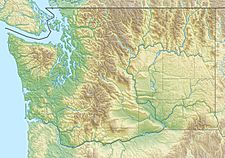Ermine Glacier facts for kids
Quick facts for kids Ermine Glacier |
|
|---|---|
| Type | Mountain glacier |
| Coordinates | 48°08′08″N 121°06′21″W / 48.13556°N 121.10583°W |
| Length | 1.25 mi (2.01 km) |
| Terminus | Ice fall and barren rock |
| Status | Retreating |
Ermine Glacier is a cool ice river found on the northern side of Glacier Peak. This peak is a large mountain in Washington, a U.S. state. Like many glaciers around the world, Ermine Glacier is getting smaller. It is slowly moving back up the mountain.
Contents
What is Ermine Glacier?
Ermine Glacier is a type of glacier called a mountain glacier. It is a huge mass of ice that moves very slowly. This glacier is located high up on the slopes of Glacier Peak. Glaciers are important because they store a lot of fresh water. They also help us understand how Earth's climate is changing.
Where is Ermine Glacier Located?
You can find Ermine Glacier on the north side of Glacier Peak. Glacier Peak is a tall volcano in Snohomish County, Washington. This area is part of the Cascade Range, a big mountain chain in western North America. The glacier's ice ends in what is called an ice fall. This is where the ice breaks apart over steep rock.
How Ermine Glacier Has Changed Over Time
Glaciers like Ermine Glacier don't stay the same size. They grow and shrink over many years. Scientists study these changes to learn about past and present climates. Ermine Glacier has changed a lot, especially since a period called the Little Ice Age.
The Little Ice Age and Glacier Growth
The Little Ice Age was a time when the Earth was cooler. This period lasted from about the 1300s to the mid-1800s. During the Little Ice Age, Ermine Glacier grew much larger. It stretched down the mountain to an elevation of about 4,400 ft (1,300 m). At its biggest, it even connected to another glacier called Vista Glacier, which is to its west.
Retreat and Advance Cycles
After the Little Ice Age ended, Ermine Glacier started to melt back. From the mid-1800s until the mid-1950s, the glacier generally moved uphill. This is called "retreating." But then, something interesting happened. From the mid-1950s to the mid-1970s, the climate became a bit cooler and wetter. This caused Ermine Glacier to grow forward again, or "advance."
Recent Retreat of the Glacier
Unfortunately, the advance didn't last very long. Since the mid-1970s, Ermine Glacier has been retreating again. Scientists have measured this change. Between 1992 and 2005, Ermine Glacier melted back about 308 m (1,010 ft). This shows that the glacier is still shrinking. Many glaciers around the world are also retreating because of warmer temperatures.


